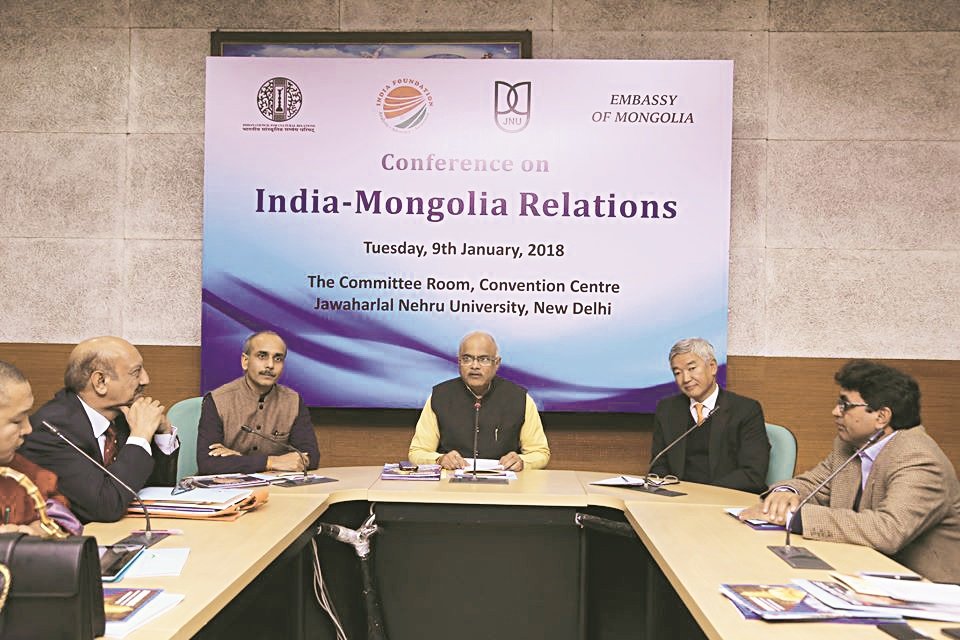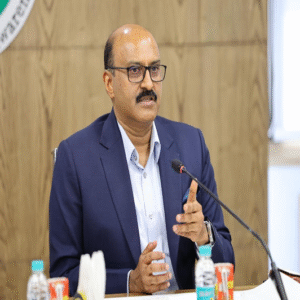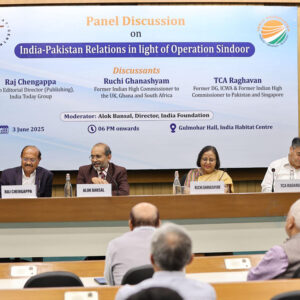A conference on India-Mongolia Relations was organised by India Foundation and Jawaharlal Nehru University (JNU) in collaboration with the Embassy of Mongolia and the Indian Council of Cultural Relations (ICCR) at the Convention Center, JNU, New Delhi. Both India and Mongolia are regions of ancient wisdom and youthful dynamism. The relation between the two can be described on the basis of the eight-fold path of Lord Buddha, which prescribe not just the path to happiness of individuals, but also a guide to the wellbeing of societies and nations. It is a message of kindness, love and compassion for all. Prime Minister Narendra Modi while speaking in the Mongolian Parliament said, “The convergence of Buddhism and democracy provides us a path to build an Asia of peace and cooperation, harmony and equality.” This conference thus aimed to further deepen the relationship as described by the Indian Premier.
Inaugural Address
Prof. R.P. Singh, Rector, JNU, said that the relation between the two countries could be seen from the prism of culture and economy. He stated that in the 21st century, soft power would be a defining factor in the relationship between states and that culture would have an important role to play. Indian culture has travelled to Mongolia through literature, films, serials, and yoga. India needs to take its relation with Mongolia to a different level by engaging more and more in different fields.
Special Address
Mr. Gonching Ganbold, Ambassador of Mongolia in India, said that India and Mongolia ties have grown in last 60 years and have seen a further spurt in the last 25 years of democracy in Mongolia. The visit of Indian Prime Minister Narendra Modi to Mongolia was a landmark event in the history of the two countries. Geographically, Mongolia is a landlocked country with abundance of natural resources. India can cooperate and assist Mongolia in its development, alleviation of poverty and unemployment. He said, “India is becoming closer to heart and mind, and now it’s the time to complement each other and move ahead shoulder to shoulder.”
Keynote Address
Mr. Vinay Sahasrabuddhe, President, ICCR, laid emphasis on the multidimensional aspect of the India-Mongolia relationship — cultural, spiritual, commercial, and business. He also highlighted the fact that both countries being democracies, added to the strength of the relationship. He also spoke of the aspirational nature of Indian society, quoting a couplet from Allama Iqbal’s ‘Tarana-e-Hind’ written in 1904 in this respect:
“Yunan-o-Misr-o-Roma sab mit gaye
jahan se ab tak magar
Hai baki naam-o-nishan hamara,
Kuch baat hai ki hasti mit-ti nahi hamari;
Sadiyon raha hai dushman daur-e-zamana hamara”.
Broadly, the English translation of the above verse is: “Greek, Egyptians and Romans have all vanished, but we are still here. There must be something special that we still exist despite the whole world being against us”.
In the above context, Shri Sahasrabuddhe said that the World is looking towards eastern civilisation, and is drawing inspiration from spirituality and culture of the East. India Mongolia relations could offer the world a gross cultural product that would be unique. He said that the time has also come to take cultural diplomacy to developmental diplomacy, where culture would provide roots to evolve development.
Session-I
Mr. S. Chuluun spoke on the heritage of Khutukhtu Monastery. He said that since the thirteenth century onwards, Buddhist literature has been translated from Tibetan and Sanskrit to the Mongolian language. Even today, there are lots of Sanskrit origin words in Mongolian language. He said that from seventeenth century to nineteenth century lots of Buddhist commentaries and books on Buddha were deciphered from Sanskrit and Tibetan by Mongolian Buddhists.
Prof. Sharad Soni spoke on the historical linkages of India and Mongolia. Quoting from former Prime Minister Atal Bihari Vajpayee he said that both India and Mongolia were ancient lands with ancient cultures. He said India is not only the homeland of Buddha but also land of knowledge. He described India and Mongolia as ‘Spiritual Neighbours.’ Buddhism reached Mongolia from India through Central Asia in 3rdcentury BCE. Buddhism is adopted as state religion in Mongolia. The Swayambhu is Sanskrit origin word, whose first letter is represented in Mongolian national flag. He pointed out how important Indian culture is in Mongolian day-to-day life. India was the first non-socialist country to be recognised by Mongolia. During 1962 India-China war, Mongolia was the first county to support India.
Ms. D Purejav talked about issues of studies of Dandin’s Kavyadarsa in Mongolian literature. Unfortunately, in last few decades the Mongolian literature is losing its oriental and native character and increasingly getting based only on western literary tendencies. Therefore, a study and comment of Dandin’s theory of poetics which bears oriental civilisation, cultural and thinking traditions, takes an important place in the development of modern Mongolian literature. In oriental literature and languages ‘Kavyadarsa’ has been played an important role like Aristotle’s ‘Poetics’ in Western literatures and languages. This Indian theory of poetics was translated into many languages such as Pali, Tibetan and Mongolian.
Mr. Ravi Bhoothalingam identified how culture and business are closely interconnected. According to him, to do business it is essential to know the shared values between the countries along with the historical understanding. He spoke about the role of Genghis Khan during the ancient time which was having globalised empire where administration was run by multinational people. He stated that learning from culture was always a two way process and this would develop a mutual trust which would act as foundation for the business.
Session- 2
- Purevsuren said that India and Mongolia were ancient cultures, which were created by the ancient people of Asia. The link between two nations is fascinating and unique by transmission of heritage and ideas. Now the two counties are moving from spiritual neighbours to strategic partners.
Ms. Rami Niranjan Desai narrated journey of Kushok Bakula Rinpoche from a Buddhist monk in India to Ambassador of India to Mongolia. He was recognised as the thirteen Dalai Lama of Bakula Arhat, one of the Sixteenth disciples of Gautama Buddha. In 1990 he took the office of India’s ambassador to Mongolia, when Mongolia was still a communist county. There was political turmoil going on in Mongolia. People who were revolting against the government wanted to meet Bakula, but being ambassador he was not supposed to meet the people who were revolting against the government. But he decided to meet them without directly talking about the politics. When he met them, he told them to never resort to violence and to remember the Indian struggle for freedom. He gave sacred threads to the people who wore them and sat on the streets, non-violently agitating against the government. After that, the talks took place and government agreed to pave the wave for democracy.

He traveled to communist Russia and there also he not only preached Buddhism but also created a Buddhist monastery. In Mongolia, he created the residential monasteries for the monks. Teachers from Sikkim and Tibet were brought for the guidance of the monks. He didn’t want to mould the monasteries on the Indian or Tibetan pattern, but he wanted to make them inclusive and orderly. He put efforts to ensure that the spiritual role of women was not ignored and they were given the same importance as men. He retired in 2000, but even after retirement, he used to visit Mongolia often as he was very attached to Mongolia. He passed away in 2003. A boy in Leh was recognised as 20th Bakula and 14th Dalai Lama.
Ms. Ayush Oyuntungalag spoke about the younger generation’s language and culture in Mongolia. She stressed on how Mongolians have been conscious about their language and culture, despite having lived among different civilisations and different cultures and how people have been able to preserve their culture.
Dr. Vaishali Krishna spoke on how the India-Mongolia relations are evolving from civilisational ties to strategic partnership. She quoted Prime Minister Narendra Modi’s statement that democracy and Buddhism bind India with Mongolia, India’s spiritual friend. The two countries share a multi dimensional relation extending from political, economical, to cultural ties. Mongolia followed the path of non-alignment. It can play a prominent role in India’s act east policy. India and Mongolia need to strengthen their economic and defence ties by involving with each other on a larger scale. Mongolia is having large number of resources that could be utilised by growing cooperation. The role of China cannot be ignored and Mongolia is following the third neighbour policy with regard to India.
Mr. Phunchok Stobdan, a former diplomat, who chaired the session, spoke about the political difficulties in the 1990s and how Kushok Bakula Rinpoche, a monk was sent as ambassador to Mongolia and the successful role he played there. He emphasised on the need to focus upon ancient Buddhist literature and monasteries like Vikramshila. The cultural and spiritual ties between India and Mongolia can become even stronger. Mongolia has got abundant natural resources but scarcity of manpower. India and Mongolia can work together to help each other in various fields.
(This article is carried in the print edition of March April 2018 issue of India Foundation Journal.)




